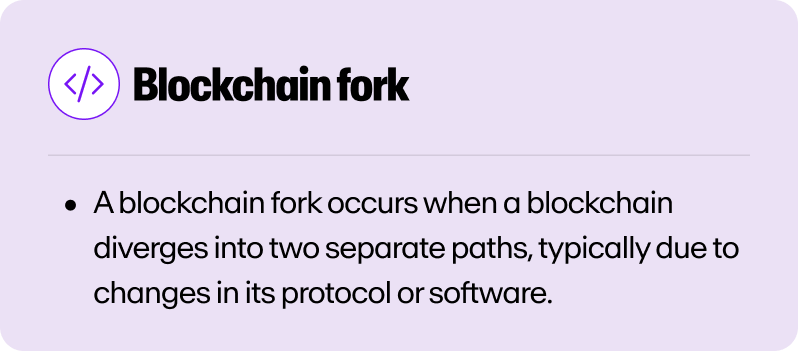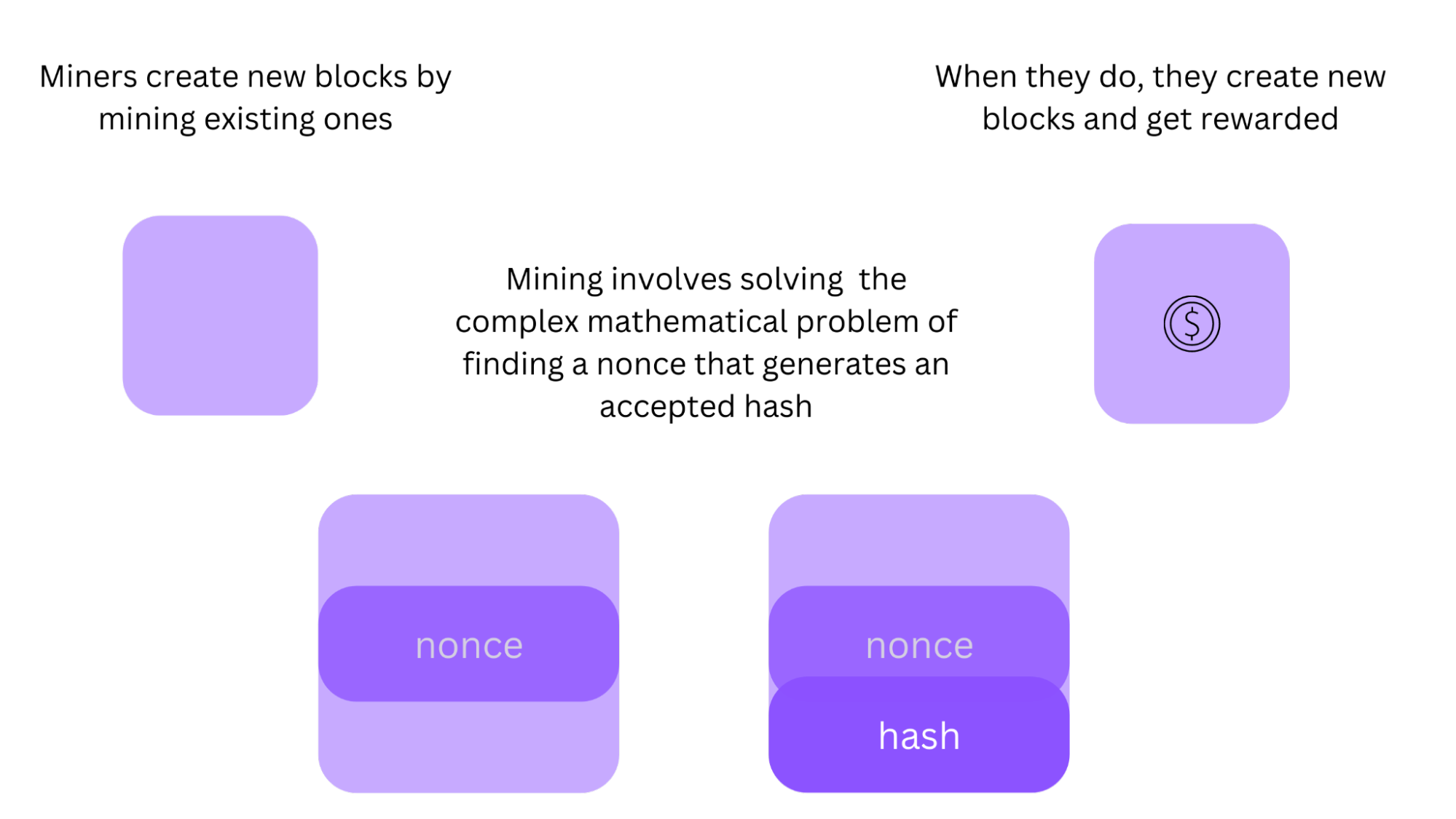What are blockchain forks and how do they work?
Blockchain forks are one of the more intriguing phenomena within the Web3 space, but what are they and how do they function? Let's dig in.
By Corey Barchat

Blockchain technology has helped transform the way we perceive value and data management. But the history of a given blockchain is not always straightforward.
You may have heard of instances of debate like Bitcoin vs Bitcoin Cash or Ethereum vs Ethereum Classic. While they were contentious at the time—and continue to be in some circles—these are important examples of blockchain forks that serve as inflection points in each token's development.
Just like a fork in the road, its Web3 counterpart also represents a divergent path in the network's journey, leading to different future outcomes and possibilities.
But what exactly are these forks, and how do they function within the blockchain ecosystem? Bring your knife and fork, and let's dig in.
What is a blockchain fork?
A blockchain fork is a divergence in a blockchain's transaction history, leading to the creation of two distinct paths. A fork occurs when consensus rules are altered, resulting in a split between nodes, miners, and users, often facilitating protocol upgrades or resolving disputes.
Forks play a pivotal role in shaping the trajectory of blockchain ecosystems, influencing the evolution and governance of blockchain networks worldwide. They enable upgrades, introduce new features, and address critical issues within the protocol.
Like their utensil namesake, Blockchain forks come in different sizes, each with its own set of characteristics and implications. From hard forks to soft forks, the variations in fork types dictate the direction and magnitude of changes within the network.

The origins of blockchain forks can be traced back to the early days of blockchain technology, where they emerged as a natural consequence of community-driven development and the decentralized nature of blockchain networks. Over time, forks have evolved as a mechanism for protocol upgrades, resolving disputes, and accommodating divergent visions within the cryptocurrency ecosystem.
How do blockchain forks work?
From the role of nodes and miners to the decision-making processes governing implementation, understanding how forks work is crucial for navigating the blockchain landscape.
Technical mechanisms behind forks
Blockchain forks occur due to changes in the underlying protocol, typically initiated through updates to the network's codebase. These changes can stem from various factors such as protocol upgrades, bug fixes, or the introduction of new features. When a portion of the network adopts these changes while others do not, a fork is created. This leads to a new version with divergent paths in the blockchain's transaction history.
Technically, forks can be initiated by altering consensus rules, modifying the block structure, or implementing new blockchain functionalities within the protocol. Nodes within the network must reach a consensus on which chain to follow, leading to the establishment of the dominant chain and the creation of an alternative chain(s) in the case of a split. But more on nodes in a bit.
Process of fork creation
The process of creating a fork generally involves several stages:
1) Identification: Changes or needs to a blockchain network are identified by the community. They could arise from user feedback, security vulnerabilities, scalability concerns, or ideological differences among members.
2) Proposal: Once the need is recognized, developers propose changes to the protocol through code modification or improvement proposals.
3) Review and testing: Following the proposal stage, the changes generally undergo review and testing by the development team and the broader community to ensure compatibility, security, and consensus.
4) Implementation: Upon reaching a consensus on the proposed changes, the fork is scheduled for activation at a predetermined block height or time. After the updated protocol goes live, the result is the divergence of the blockchain into multiple chains, and the creation of separate cryptocurrencies.
Role of nodes and miners
Nodes and miners play crucial roles in the execution and resolution of blockchain forks.
Nodes are responsible for validating transactions and maintaining a copy of the digital ledger, while miners contribute computational power to secure the network and add new blocks to the blockchain.
During a fork, nodes and miners are faced with the decision of which chain to support based on the consensus rules defined by the protocol. Nodes may choose to upgrade to the new version of the blockchain protocol, signaling their acceptance of the changes, while miners decide whether to mine blocks on the original blockchain, the forked chain, or both.

The collective actions of nodes and miners determine the outcome of the fork, with the longest chain typically being recognized as the valid chain by the majority of the network.
However, contentious forks may result in the emergence of competing chains, requiring additional consensus mechanisms or governance processes to resolve the dispute. More on those later.
Consensus and governance in fork decision-making
Consensus and governance mechanisms play a critical role as well. Consensus mechanisms such as Proof-of-Work and Proof-of-Stake determine how nodes and miners agree on the validity of transactions and the ordering of blocks within a blockchain.
Governance frameworks, on the other hand, provide a structured approach for managing protocol changes and resolving disputes within the blockchain community. These frameworks may involve voting mechanisms, governance tokens, or decentralized autonomous organizations (DAOs) to facilitate decision-making and ensure the alignment of stakeholders' interests.
Decisions regarding fork implementation are typically made through transparent and inclusive processes, involving input from developers, miners, node operators, investors, and other stakeholders. Governance mechanisms can help establish legitimacy, transparency, and accountability in the decision-making process, attempting to create trust and consensus within the community.
Different types of blockchain forks
From hard forks with irreversible changes to soft forks introducing backward-compatible updates, each type offers unique advantages and challenges.
Hard Fork
A hard fork represents significant and irreversible changes to a blockchain protocol, resulting in the permanent divergence from the original blockchain.
They require all participants to upgrade their software to continue participating in the network, as nodes and miners enforcing the new rules will reject blocks that do not adhere to the updated protocol. Usually, a hard fork creates substantial changes, such as modifications to consensus algorithms, block size limits, or governance structures.
Notable examples of hard forks include Bitcoin Cash, which split from Bitcoin to increase block size, and Ethereum Classic, which diverged from Ethereum following the DAO hack to maintain the original blockchain's integrity.
Soft Fork
Soft forks are backward-compatible changes to a blockchain protocol that do not require all participants to upgrade their software.
Instead, these forks tighten consensus rules, making previously valid transactions or blocks invalid according to the updated protocol. Soft forks are typically implemented through changes that restrict or redefine existing functionalities, allowing upgraded blockchain nodes to enforce the new rules while non-upgraded nodes remain compatible with the network.
They are generally less disruptive than hard forks and can be deployed more seamlessly, as they do not necessitate a unanimous upgrade by all network participants.
Examples of soft forks include the implementation of Segregated Witness (SegWit) in Bitcoin, which introduced transaction malleability fixes and increased block capacity without requiring a hard fork, and the introduction of BIP66 to enforce strict DER encoding rules for signatures.
Planned vs. Contentious Forks
Planned forks
These are deliberate and coordinated events initiated by developers or community consensus to implement scheduled upgrades or introduce new features to the blockchain protocol. As the name suggests, they are typically well-organized, with clear communication and broad support from stakeholders. Examples include protocol upgrades like Ethereum's Istanbul and Berlin hard forks, aimed at enhancing network scalability and functionality.
Contentious forks
This type of fork arises from disagreements within the blockchain community regarding proposed changes to the protocol, resulting in a split in the network. These forks often stem from ideological differences, governance disputes, or conflicting visions for the blockchain's future.
Contentious forks can lead to the creation of competing chains, each supported by factions advocating for divergent approaches. Notable examples include the Bitcoin Cash hard fork, which occurred due to differing opinions on block size limits and scalability solutions, resulting in the formation of separate Bitcoin Cash (BCH) and Bitcoin SV (BSV) chains.
Temporary vs. Permanent Forks
Temporary forks
Sometimes called chain reorganizations, temporary forks occur when multiple valid blocks are mined simultaneously, causing a temporary divergence in the blockchain's history. However, these forks are typically short-lived, as the network eventually converges on the longest chain, which is considered the valid chain.
Temporary forks may result from network latency, mining competition, or propagation delays and do not typically require manual intervention to resolve. Blockchain networks employ consensus mechanisms like proof-of-work to mitigate the occurrence and impact of temporary forks.
Permanent forks
These represent enduring splits in the blockchain network, resulting from irreconcilable differences in consensus rules or protocol implementations. Unlike temporary forks, permanent forks lead to the establishment of separate and distinct chains, each with its own transaction history and community of users.
These can be intentional forks, such as a hard fork aimed at introducing fundamental protocol changes, or an unintentional permanent fork, arising from critical vulnerabilities or irreparable consensus failures. Examples of permanent forks include Ethereum Classic, which resulted from the Ethereum network's response to the DAO hack, and Bitcoin Cash, a contentious hard fork of Bitcoin aimed at increasing block size limits.
Advantages of blockchain forks
Despite their disruptive nature, blockchain forks offer several benefits that contribute to the growth and resilience of their networks.
Upgrades and enhancements
Forks can serve as catalysts for innovation, enabling the implementation of new features and functionalities that enhance the user experience and expand the capabilities of blockchain networks.
Security improvements
By addressing vulnerabilities and strengthening network defenses, forks can help bolster the security posture of blockchain ecosystems, mitigating risks associated with malicious attacks and exploitation.
Addressing disagreements
Forks provide a mechanism for resolving ideological differences and technical disputes within the blockchain community, in the name of collaboration and consensus-building among stakeholders.
Responding to hacks
In the event of security breaches or protocol vulnerabilities, forks might offer a means of remediation and recovery, allowing blockchain networks to adapt and evolve in response to emerging threats.
Risks associated with forks
While forks offer numerous benefits, they also introduce risks and challenges that can impact network stability, user confidence, and regulatory compliance. Understanding these potential drawbacks is essential for navigating the complexities of fork events.
Splits and fragmentation
One of the primary risks associated with forks is the potential for network splits, resulting in fragmented ecosystems and diminished network effects.
Security risks
Forks may inadvertently introduce security vulnerabilities or weaken network defenses, exposing users to potential financial losses and reputational damage for the platform.
Adoption issues
Complex fork events can potentially confuse users and stakeholders, leading to uncertainty and hesitation regarding network participation and inhibiting adoption.
Regulatory and legal implications
Regulatory scrutiny and legal uncertainty surrounding fork events can impede innovation and investment in blockchain technologies, hindering ecosystem growth and development.
How to navigate an upcoming blockchain fork
Navigating an upcoming fork requires vigilance, preparation, and an understanding of best practices, to help mitigate risks and safeguard assets.
Best practices for users and developers
- Stay informed: Users can follow reputable sources like cryptocurrency news sites, official project announcements, developer forums, and social media channels to monitor pre- and post-fork updates, including software patches, community initiatives, and regulatory developments.
- Verify sources: Verify the legitimacy of fork-related information and instructions before taking any actions, such as claiming or trading forked assets. This may help to protect assets during and after a fork, as well as avoid falling victim to phishing attacks and other scams.
- Conduct due diligence: Research the proposed changes and implications of the upcoming split to assess its potential impact on your operations or cryptocurrency stake.
- Backup your assets: Ensure that you have secure backups of your private keys to prevent unauthorized access or loss of funds. Prior to the fork, confirm you have access to a trusted wallet/exchange that will support the forked assets.
- Test before committing: If you're a developer, test the forked software in a controlled environment to identify any compatibility issues or unforeseen challenges.
Blockchain fork FAQs
1) What is the difference between a hard fork and a soft fork?
In a hard fork, the blockchain protocol undergoes a significant and irreversible change, resulting in a permanent divergence from the original chain. A soft fork, on the other hand, introduces backward-compatible changes to the protocol, allowing both upgraded and non-upgraded nodes to coexist on the same network.
2) How do I claim forked assets after a blockchain fork?
To claim forked assets, you typically need to hold the original cryptocurrency in a compatible wallet or exchange at the time of the fork. Depending on the specific split, instructions for claiming the new cryptocurrency assets may vary. Users should research and follow the official guidelines provided by the project team to ensure a secure and successful asset claim process.
3) How do developers decide to implement a fork?
Developers may decide to implement a fork for various reasons, including software protocol upgrades, consensus rule changes, addressing security vulnerabilities, or resolving contentious issues within the community. Fork decisions typically involve consensus-building among stakeholders, with proposals undergoing rigorous evaluation and testing before implementation.
4) What should I do if I disagree with a proposed fork?
If you disagree with a proposed fork, you can express your dissent through community forums, social media channels, or governance/voting mechanisms established by the project team. Engaging in constructive dialogue and presenting alternative viewpoints can help positively influence the decision-making process and shape the future direction of the project.
5) How can I protect myself from scams and phishing attempts during a fork?
To better protect yourself from scams and phishing attempts during a fork, exercise caution and follow best security practices. Be wary of unsolicited messages or emails claiming to provide instructions, and only interact with trusted sources of information, such as official project websites and communication channels. Additionally, always use secure wallets and avoid sharing sensitive information, such as private keys or passwords.
Access cryptocurrency forks
The best way to learn about blockchain splits is to explore them yourself. To do so, you'll need to acquire the cryptocurrency native to forked projects.
MoonPay makes it easy to buy cryptocurrency derived from forks, such as Bitcoin (BTC), Bitcoin Cash (BCH), Ethereum, and Ethereum Classic (ETC). Pay your way, via MoonPay or through any of our partner wallet applications with a credit card, bank transfer, Apple Pay, Google Pay, and many other payment methods.
Just enter the amount of cryptocurrency you wish to purchase and follow the steps to complete your order.






